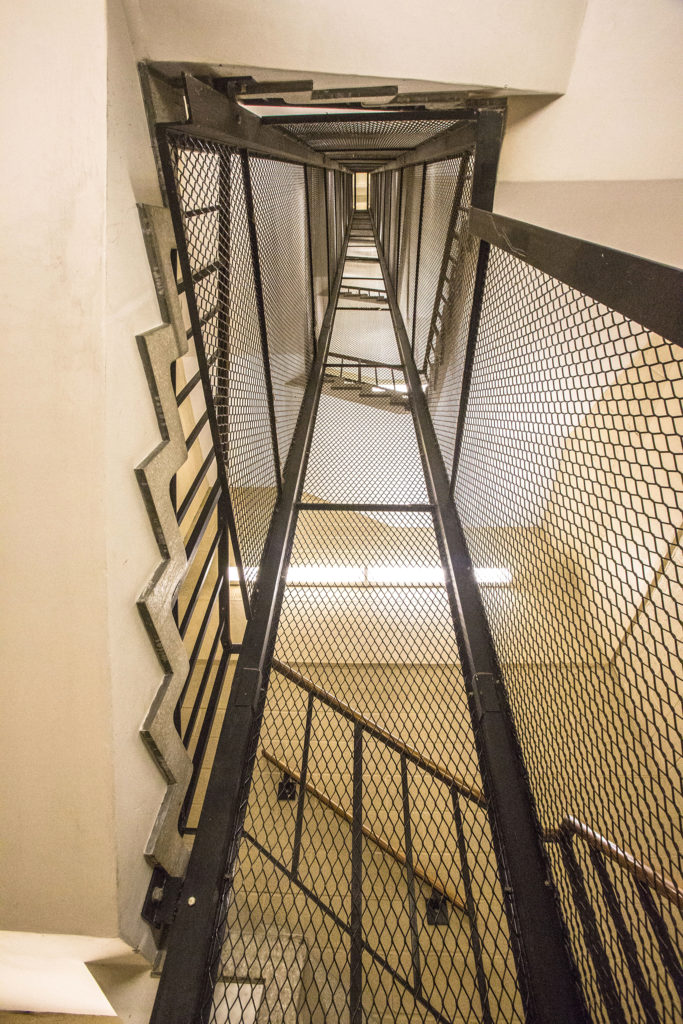Urban(a) Legends
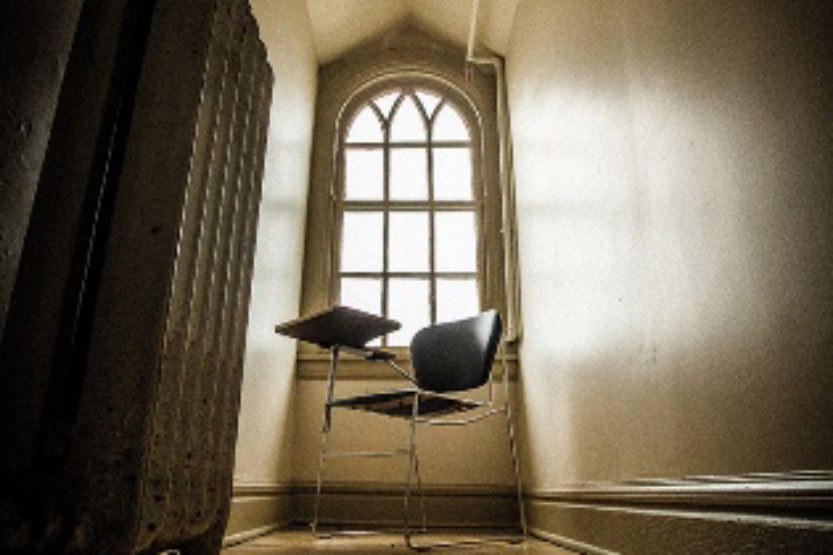 The English Building
(Photo by L. Brian Stauffer)
The English Building
(Photo by L. Brian Stauffer) Just off the Quad, where John Milton Gregory rests permanently from his exertions as first president of the University of Illinois and Alma Mater’s empty plinth hulks somber as a headstone, it is possible to hear the creak of the many mysteries of campus—tales of old buildings with odd corners and freakish apparitions and things buried underground.
So burnished by time are some of these stories that freshmen arrive already knowing them. Susan Gray Davis, a UI folklore professor, sends undergraduates out to query their peers about such lore and legends; the students return to class year after year with the same stories, endlessly embellished. These living tales, says Davis, are fascinating—particularly to those new to campus—because they “help students make sense of this strange environment they’re in.” Such lore also steadies the young as they come to terms with loss and mortality.
“There really are scary things that happen,” she observes. “Students may not act like it, but death is very real to them.”
Deeper meanings make stories all the better in the retelling. As do the details, wherein the devil is said to reside. So—what is the inventory of Urbana’s legends of the halls? How much truth beats at their hearts? Settle in as Illinois Alumni takes a velvet chainsaw to some of Alma Mater’s most enduring scary tales.
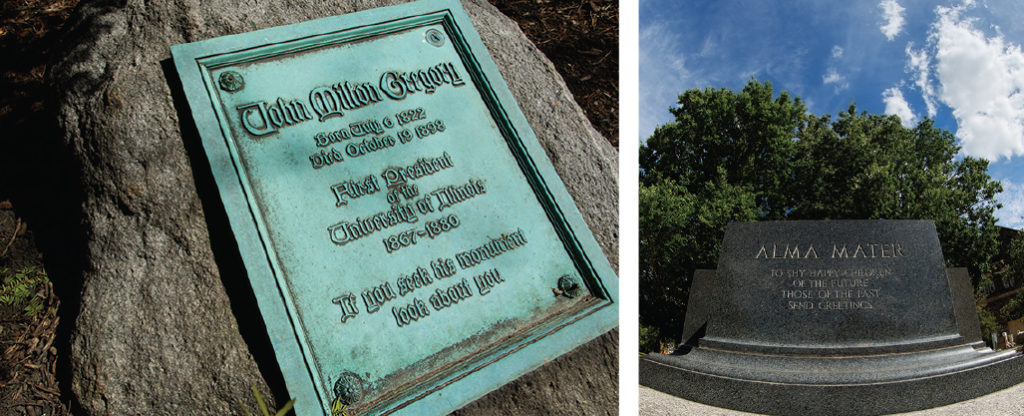
The grave of John Milton Gregory (left), first president of the University. Alma Mater’s lonely plinth (right) awaits the iconic statue’s return from restoration. (Images courtesy of UI Public Affairs)
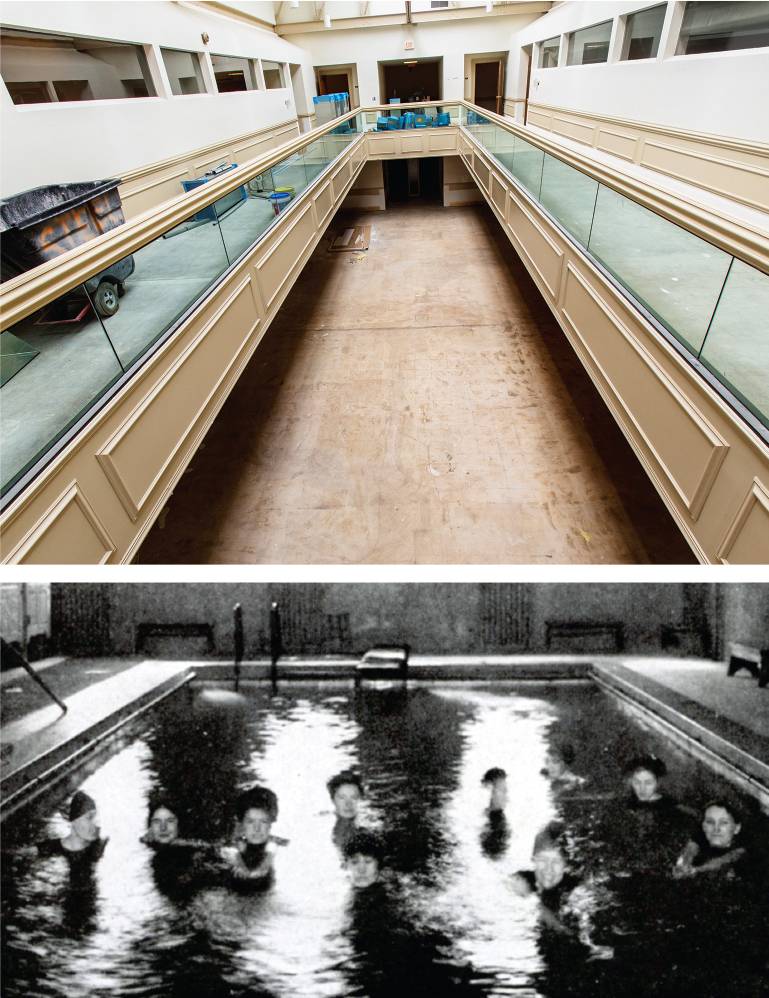
The English Building pool has disappeared, remodeled into an atrium. (Atrium image by L. Brian Stauffer and historic pool images courtesy of “Illini Years”)
Spirits in the night
The wraith that flits most eerily across the collective consciousness of the University of Illinois surely belongs to the English Building, where narrow dormers, stern towers and long, blank corridors murmur of an earlier life. Originally a residence hall for women (1905-1937), the structure once sported a swimming pool (since handsomely renovated into an atrium), where a resident is said to have drowned herself, motivated by failing academic performance or unwanted pregnancy. (One lurid variation has her murdered in her room.) And so, the story goes, lights blink on and off, and doors fall open and slam shut, and spots get cold all by themselves, and wails are heard. The ghost has been reported—though not in any firsthand account uncovered by us—wandering the halls and gazing from a window on the third story. Her legend has inspired uncounted late-night expeditions by curious students and several videos à la Ghost Hunters, all viewable on YouTube and all inconclusive.
UI archivist Chris Prom, PHD ’04 LAS, is more definite. “I have never seen any evidence that someone drowned in that pool,” says Prom, who has become, despite many more pressing claims on his time, a go-to guy for campus lore and legends.
Amid the stupendous University-related documentation that crams his professional quarters in the Main Library’s basement, Prom maintains a small file of newspaper clippings and other material (including an undergraduate paper by Nichol Chontofalsky ’09 LAS) that traces campus hauntings and horrors. A face, for example, is said to sometimes gaze from a window high in the lean, elegant expanse of Lincoln Hall, perhaps scanning for its sister spirit in the English Building next door.
From the University YMCA, on Wright Street, comes the tale of a Native American chief who used to step by night from his portrait in the basement to mount the stairs and prowl amid the oak-beamed arches and lead-paned windows (lured no doubt by the lingering aroma of the Thai food served by the Y’s tiny cafeteria). However, since his removal to storage, he seems more inclined to stay within the frame.
Lost souls of a musical bent are said to haunt the Harding Band Building, though Scott Schwartz, who has worked there since 2003, dismisses the visitations as a combo of creaky infrastructure and staff banter. Jokes Schwartz, who heads the Sousa Archives and Center for American Music: “When we play jazz, I have no doubt John Philip Sousa [famed for his marching band arrangements] is kicking up a ruckus.”
Terrible tales and viral rumors
There are true events, though, and some are awful, such as the one behind the chain links that cage the eight-story stairway in the Psychology Building’s southwest corner. The cage was installed after two students fell down the stairwell in 1975, one to her death, deemed a suicide. Esteemed psychology professor Ed Diener, whose research specialty is happiness, recalls his thoughts when he learned of the tragedy. “If only she could have gotten through the tough period, perhaps with the help of others, she would have come out of her depression, and it would be in the past,” he says. “Depression almost never lasts forever, and this is why young deaths from suicide are so very tragic.”
Even more horrifying, a computer programmer was raped and strangled on Halloween night 1995 in the building at 1207 W. Oregon St. (then the School of Social Work, and now home to the Department of Communication) by a student who later killed himself by jumping in front of a train.
The aura of terror this murder cast over campus may account for the widespread panic three years later when a well-worn urban legend went viral. In the fall of 1998 a psychic was said to have appeared on Oprah and forecast a Halloween mass murder on a Big Ten campus. (There was no such television appearance, and similar stories date back to 1968, according to myth-busting websiteSnopes.com.) The description of the predicted site—an H-shaped dormitory near a cemetery—fit Pennsylvania Avenue Residence Halls. Students got scared, University spokespeople issued statements, and Oct. 31 found extra RAs on duty at the building and also at Florida Avenue Residence Halls—though a housing coordinator protested to The Daily Illini that such precautions were customary on a night when strange creatures are known to walk abroad (including, in more recent years, the mob of zombie impersonators that oozes every Halloween from Allen Hall).
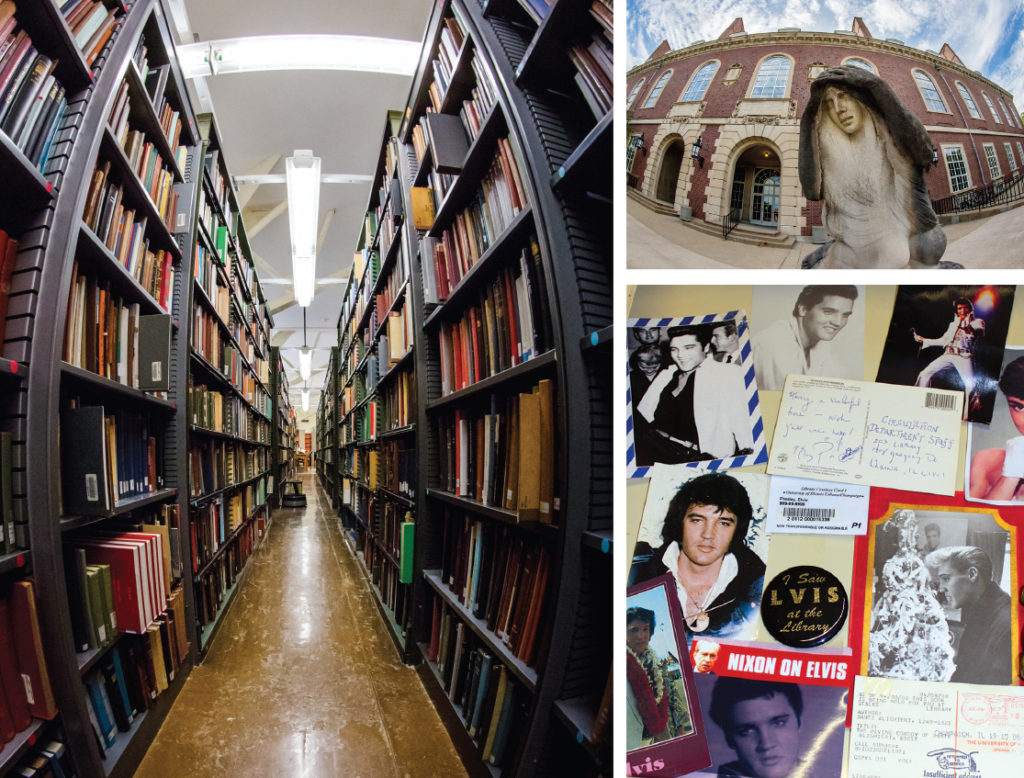
Repository of campus lore and legends, the Main Library (top right) houses the endless, echoing warren of the stacks, where a spirit is said to wander. The Elvis Shrine, which came into being under mysterious circumstances, may be found there. (Library images by L. Brian Stauffer, Elvis Shrine image by Stephanie Swift)
The Library and the King
Back at the Main Library, an unverified spook wanders—perhaps seeking an arcane tome for a long-ago term paper—among the stacks, loaded with one of the largest collections of books in the world and prone to rumors of structural sinkage. More substantially, the Library houses an X Files-caliber trove of literature that includes books on mediumship, reincarnation, witchcraft, out-of-body experiences and cryptobiology. The collection, distributed throughout the Library by call number, hails from a 1984 endowment by the late Merten J. Mandeville ’21 BUS, MS ’22 BUS, PHD ’35 BUS, a UI professor of management and an otherwise seemingly practical kind of guy. “I would never have imagined he’d be interested in books like that,” observes retired College of Business administrator Fred Neumann. Mandeville, who died in 1976, did dabble in stock-market predictions, though we cannot say how successful his prognostications proved.
On a Library shelf of its own is the Elvis Shrine, a phenomenon dating to 1994. That is when an unknown person sent Elvis Presley, on behalf of the University Library, official postcard notification that a copy of Dante’s Divine Comedy was being held for him at the circulation desk. Bearing the address of Graceland Memorial Cemetery (Presley’s abode then, as now), the card was dutifully returned to sender by the U.S. Postal Service as undeliverable, despite its correct ZIP code. For more than a decade, it hung in a metal case near the circulation desk, magically attracting other postcards—some purportedly from Elvis himself—and oddities such as a small plastic bear with red eyes. (Exactly what this object had to do with Elvis is unknown.) Alas, duct and drywall work in 2008 necessitated the shrine’s removal to the remote corridor of the stacks where it now dwells, somewhat unappreciated.
While many of the Urbana campus legends float unverified through time, if not space, others are supported by testimony. A disembodied elevator operator in the Natural Resources Building has been reported by Steve Herrington ’97 LAS, MS ’99 ACES, who, as a graduate student, spent a lot of nights amid the building’s accumulations of rocks, insects and other specimens. Alumni have contacted us with stories from their student days of an apparition in retro nurse’s uniform at McKinley Health Center and an Allen Hall poltergeist who threw posters and artwork around a program adviser’s room. (Other, more practical, respondents issued stern reprimands for our interest in the paranormal.) A phantom stenographer (perhaps drawn from the ghostly extra-help pool) was heard pounding a typewriter in Davenport House by staff who shared their experiences with campus newspaper Inside Illinois. (Davenport House has since undergone demolition, thought to be unrelated.)
A Lady in White used to visit the night manager—he describes his experiences in a YouTube video—at stately Allerton manor in Monticello, Ill. No specter-associated death is on record for the historic, University-owned estate—perhaps her appearances are inspired by some other psychic trauma, as yet unearthed.
Tale from the crypt?
Our final legend of the U lurks in the basement of Noyes Laboratory, where a brick-walled cul-
de-sac, locked behind several storage rooms, is said to contain a grave. In 2006, a disturbing photo of the chamber, which showed a white cross with yellow flowers next to a coffin-sized depression in the dirt floor, was emailed to the Library’s reference desk by then-student Martin McCormick ’10 ENG. McCormick wanted to know if Arthur W. Palmer, a distinguished chemistry professor who died in 1904, was buried there.
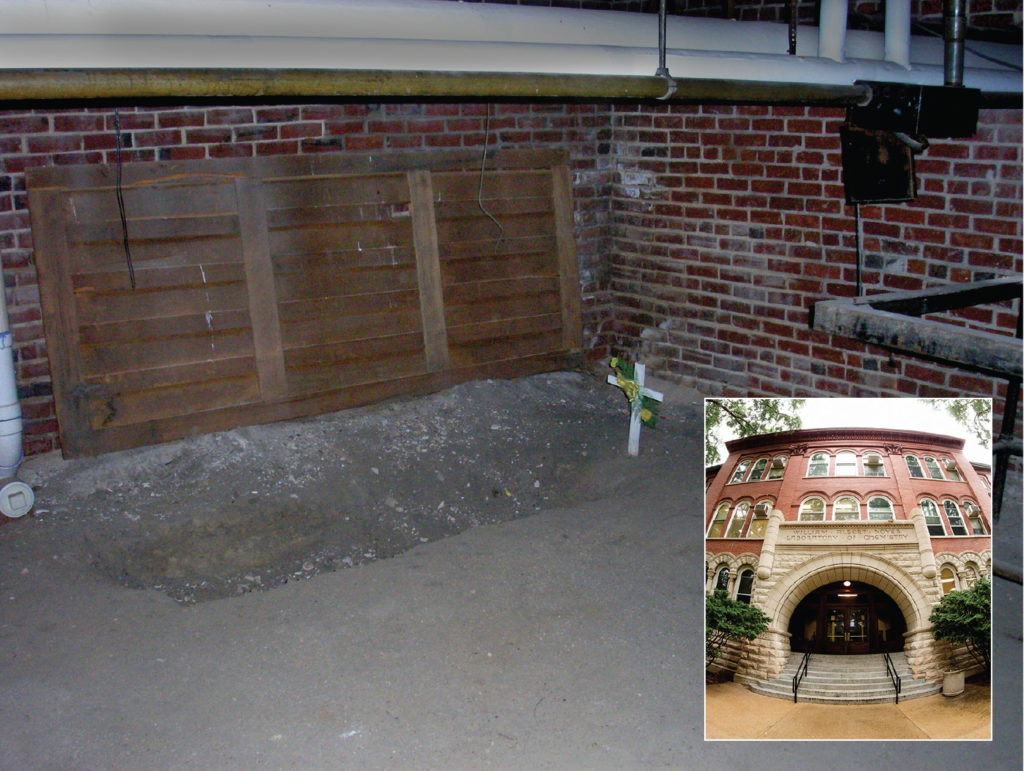
Deep in Noyes Laboratory, inset, a basement room is rumored to contain the grave of a prominent chemist or two. (Images courtesy of UI Public Affairs)
Palmer being verifiably housed at nearby Mount Hope Cemetery (some attributed his demise to overwork), the mystery subsided. Then another photograph surfaced in 2009. A portrait of chemist Edward Mörley (1838-1923) had joined the white cross and yellow flowers in the room, which looked creepier than ever. The photo appeared in The Daily Illini, alongside somewhat disappointing revelations from DI writer Jill Disis ’12 MEDIA that the grave was a hoax. Mörley, a New Jersey chemist known for his work on gases, had never so much as visited the U, much less died and been shoveled under by his peers here. The portrait belonged to the chemistry department and had mysteriously migrated cellarward from its home in a conference room three floors above. The hole probably contained—and probably still contains—plumbing. No one knows where the cross and flowers came from, nor whence they disappeared, replaced by two sticks bound at right angles, as if by some phantasmagorical Boy Scout.
Like the ghost in the English Building, the grave in Noyes Laboratory has gone on to robust video success, including a professional-grade YouTube trailer for the never-to-be-completed movie Noyes, in which students run through the building to suspenseful demonic chanting. The strange cul-de-sac is nowhere to be seen in the video—probably because maintenance staffers endeavor to keep access under lock and key. There is, nonetheless, a Facebook page of students, lying by turns in the “grave.”
Weird. But true.
In this case anyway.
In the end, many legends of the halls remain untold. Perhaps some future issue of Illinois Alumni, date unknown, will arrive bearing further stories of strange things unearthed in our research, from radioactive sheep (rumored to be buried on campus) to the Foreign Language Building (said to be designed to collapse outward in the event of nuclear strike).
But for now our investigations waft to a close, borne off into the winds of autumn and the endless, mutating talk that is the lifeblood of legends, lore, rumors and hoaxes everywhere. A copy of this account will find its way into the special file in the Library basement, helping make the unknown more known to those who take the time to share our Urban(a) legends.
BACK to SCHOOL?
Poised like a ghostly student taking notes in class, the glowing presence in the Lincoln Hall Theater is “created by a beam of sunlight,” according to Charles Lincoln ’74 LAS, who took these snaps last October at an open house celebrating the building’s return to life after extensive renovations. Having shared the pix in an email to Illinois Alumni, the photographer (who, curiously, shares his name both with the magnificent Quad structure and a very famous president) concluded: “Nothing supernatural, I’m afraid.” Very afraid. (Not.)
CAMPUS HAUNTS
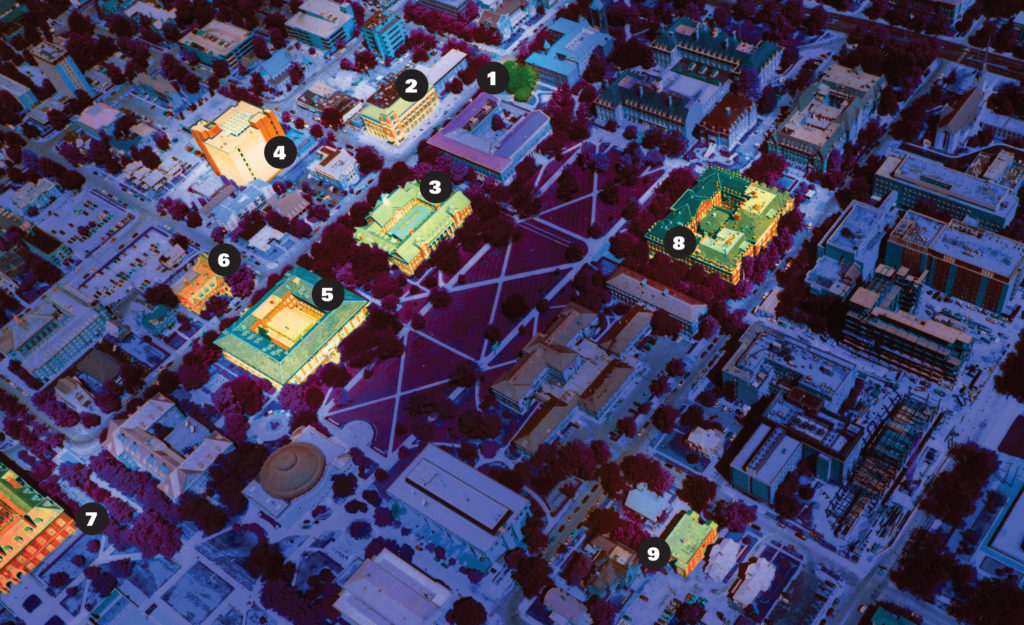
1 Grave of John Milton Gregory, 2 Site of Davenport House, 3 English Building, 4 Psychology Building, 5 Lincoln Hall, 6 University YMCA, 7 Main Library, 8 Noyes Laboratory, 9 1207 W. Oregon St. (Image courtesy of UI Archives/Jen Dahlgren)

